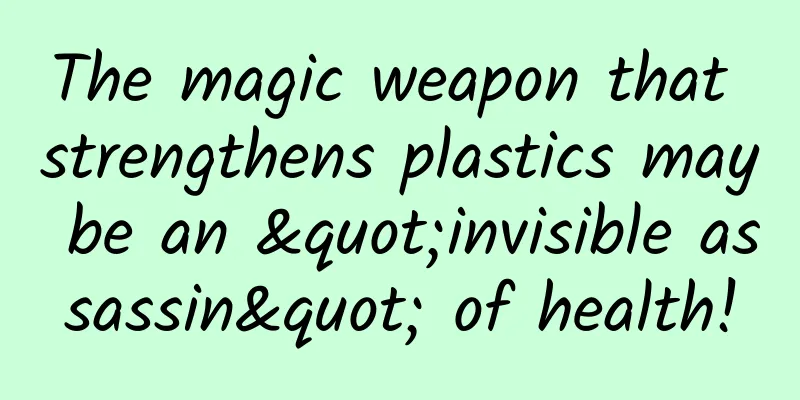The magic weapon that strengthens plastics may be an "invisible assassin" of health!

|
Audit expert: Zhou Hongzhi Senior Experimentalist, Master Supervisor, School of Physics and Optoelectronic Engineering, Beijing University of Technology Nowadays, plastic products are everywhere. From packaging materials to daily necessities and cosmetics, from medical devices to building materials, they have penetrated into every aspect of our lives with their lightness, durability and low cost, greatly enriching and facilitating our daily lives. However, with the widespread use of plastic products and the deepening of scientific research, the potential health threats of plasticizers have gradually surfaced, which needs to attract people's wide attention. What are plasticizers? Plasticizers are widely used polymer material additives in industrial production, also known as plasticizers. Any substance added to polymer materials that can increase the plasticity of polymers is called a plasticizer. The use of plasticizers can improve the performance of polymer materials, reduce production costs, and improve production efficiency. Plasticizers are an important type of chemical product additives, and are widely used as additives in plastic products, concrete, plaster, gypsum, cosmetics, cleaning agents, etc. Especially in polyvinyl chloride plastic products, in order to increase the plasticity and strength of plastics, phthalates need to be added, and their content can sometimes reach 50% of the product. The main function of plasticizers is to enhance the flexibility and plasticity of plastic products, making them easier to process and use. Plasticizers are not inherent components of plastics, but rather additives. During the plastic production process, manufacturers will add a certain amount of plasticizers in order to achieve the required performance indicators. Plasticizers can be used legally for industrial purposes and are widely found in food packaging, cosmetics, medical equipment, and environmental water bodies. For example, plastic wrap, food packaging, toys, etc. all contain plasticizers. At present, thousands of plasticizers have been developed and produced in the world, and my country produces about 100 kinds. Why are there invisible health threats? Plasticizers are fat-soluble substances. Under certain conditions, they can easily migrate from plastics and enter the environment and food chain. They can enter the human body through the digestive tract, respiratory tract and skin, posing potential hazards to human health. According to the degree of harm to the human body, plasticizers can be classified into non-environmentally friendly and environmentally friendly plasticizers. Non-environmentally friendly plasticizers mainly refer to ortho-phthalate and para-phthalate plasticizers, which have benzene ring structures and poor migration resistance and extraction. Trimellitate esters, fatty dibasic acid esters, citrate esters, epoxies, polyols, polyesters and other varieties are defined as environmentally friendly. Current studies have confirmed that phthalate plasticizers can enter the human body through three pathways: oral ingestion, respiratory inhalation, and skin penetration. They are considered to be one of the most productive environmental estrogens produced by humans themselves and have been listed as priority pollutants by countries around the world. Since 2016, many countries around the world have introduced a series of laws and policies to restrict the use of non-environmentally friendly plasticizers. my country has also formulated 17 standards to restrict the use of phthalate compounds in food packaging, drinking water, cosmetics, health care and other fields. The reason why it is not completely banned is that the role of dioctyl phthalate and dioctyl terephthalate in the production of some products is currently irreplaceable. However, from the perspective of the external environment, the decline in demand for non-environmentally friendly plasticizers is an inevitable trend. What are the effects of plasticizers on human health? 1. Damage to the reproductive system: Studies have shown that plasticizers have estrogen-like effects, which can interfere with the normal function of the human endocrine system and cause damage to the reproductive system. Long-term exposure may lead to problems such as decreased sperm count in men and premature puberty in women. 2. Liver damage: Plasticizers are mainly metabolized by the liver in the human body. Long-term intake of plasticizers will increase the burden on the liver and cause liver damage. In severe cases, it may lead to cirrhosis or even liver cancer. 3. Immune system suppression: Plasticizers can affect the body's immune function, reduce resistance, and make it easier to get infected with diseases. 4. Cancer risk: Some plasticizers are carcinogenic and long-term exposure may increase the risk of cancer. How to avoid the harm of plasticizers? 0 1 Reduce the use of plastic products Especially plastic products that come into direct contact with food and drinks, such as plastic wrap and bags, fast food boxes, plastic bottles and cups, food packaging materials, etc. should be replaced with high-quality glass, ceramic or stainless steel products. 0 2 Pay attention to food safety When purchasing food, pay attention to the labels on the packaging, avoid purchasing food containing plasticizers, and reduce the use of take-out, fast food and processed foods; do not put food wrapped in plastic wrap in the microwave; try to avoid using plastic containers to store hot water, hot soup, tea, coffee, etc.; try to use less plastic containers to heat food in the microwave. 0 3 Store food properly Avoid using plastic containers to store food, especially greasy food, high-temperature food and food containing alcohol, because plasticizers are more likely to migrate out under the influence of high temperature, grease and alcohol. 04 Reduce skin contact Plasticizers are often used as fixatives. Lipsticks, perfumes, nail polishes and some cosmetics may contain plasticizers. Avoid using plastic products to hold chemicals such as detergents. When choosing children's products, do not choose plastic products that are too soft. Do not use plastic combs. Do not choose slippers that are too soft, etc., to reduce the amount of plasticizers entering the human body through skin contact. 05 No three-no plastic products are used Choose products from regular manufacturers with certificates of conformity. Be especially careful when purchasing plastic products that come into contact with food. |
<<: When Science Meets Doubt: The "Unbreakable Glass" of 1970
>>: This mangrove wetland is not only beautiful, but also has these functions...
Recommend
Six trends in brand experience reshaping in 2022
Red Havas, a global micro-network of integrated m...
Emotional cycle tactics! Video course on catching monsters! Learn to buy low with strong trends without any basic knowledge
Emotional cycle tactics! Video lessons on catchin...
All things grow with the help of the sun. Is it possible to grow without it?
For reprinting, business cooperation, please scan...
Twelve ultimate methods of WeChat promotion, the latest in 2015
【Micro Promotion】Twelve WeChat promotion methods ...
There is formaldehyde in dishwashing liquid, can it cause cancer?
"Dishwashing liquid contains formaldehyde, w...
What is the most reasonable way to eat three meals a day? Many parents have made a mistake. Be careful that the more supplements you give your children, the worse they will be.
It is summer vacation, and we are not as busy as ...
How to solve the problem of self-driving cars being frequently forced to stop by experienced drivers
We only know that autonomous driving has become a...
After reading these copywritings, I began to cherish entertainment variety shows~
Which online variety show is the best in China in...
Behind the Remix OS hardware carnival: Which is more promising, upgrading monitors or making game consoles?
It has been a long time since I have seen a manuf...
Feeding a Tibetan brown bear privately causes it to rush towards tourists? It's really a life-threatening move!
Recently, a video of a Tibetan brown bear chargin...
How to use SMS to attract and recall lost users?
There are three common methods of user recall or ...
How do operators build a data analysis framework?
Data analysis, as a core skill that operations pe...
2022 Alipay Collection of Five Blessings Official Guide: More than 1,000 merchants will issue blessing cards
Although it is complained by many people every ye...
China's Sky Eye: Exploring the Mysteries of the Universe
The China Sky Eye (FAST) is currently the largest...
Analysis of "HEYTEA" growth strategy!
Growth Effect Store size: At the end of 2018, the...









